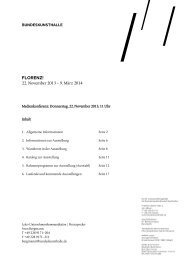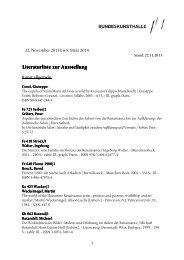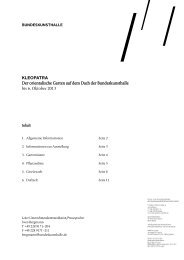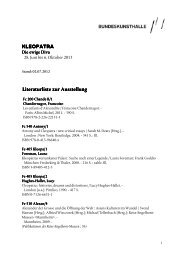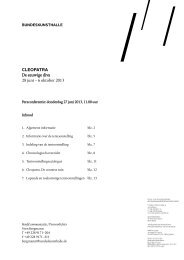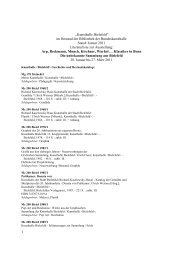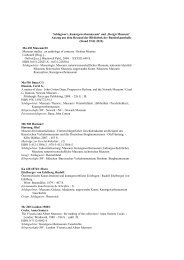Peoples through space and time Archaeology in Germany 09.05 ...
Peoples through space and time Archaeology in Germany 09.05 ...
Peoples through space and time Archaeology in Germany 09.05 ...
You also want an ePaper? Increase the reach of your titles
YUMPU automatically turns print PDFs into web optimized ePapers that Google loves.
archaeological appearance that existed over a period of 500 years <strong>in</strong> the loess soil areas of Central <strong>and</strong><br />
Eastern Europe. As of 5500 B.C., these culturally homogenous farm<strong>in</strong>g societies apparently spread <strong>in</strong><br />
waves from the South East <strong>in</strong>to North Western Europe.<br />
Extensive excavations <strong>and</strong> settlement analysis <strong>in</strong> the Rh<strong>in</strong>e Valley brown coal quarries or <strong>in</strong> Saxony<br />
have provided <strong>in</strong>sights <strong>in</strong>to the acquisition of l<strong>and</strong> <strong>and</strong> settlement processes dur<strong>in</strong>g the Late Stone Age.<br />
A region became developed <strong>through</strong> the establishment of ‘pioneer settlements’ - consist<strong>in</strong>g of a few<br />
long houses - along rivers <strong>and</strong> valleys <strong>in</strong> an otherwise densely wooded area. These settlements soon<br />
grew <strong>in</strong>to larger, ma<strong>in</strong> hamlets for an agricultural settlement area.<br />
The end of the L<strong>in</strong>ienb<strong>and</strong>keramik on the threshold to the middle Neolithic around 4800 B.C. is<br />
characterized by crises. This is reflected <strong>in</strong>, among other th<strong>in</strong>gs, re<strong>in</strong>forced settlements <strong>and</strong> the<br />
discovery of the rema<strong>in</strong>s of persons killed <strong>in</strong> the settlement near Talheim on the Neckar River.<br />
Well Construction 7000 Years Ago<br />
In 1990 the rema<strong>in</strong>s of a formerly 13-meters-deep well were found <strong>in</strong> the l<strong>in</strong>ienb<strong>and</strong>keramik settlement<br />
of Erkelenz near Mönchengladbach. Archaeologists excavated seven meters of the well-cas<strong>in</strong>g made of<br />
huge oak planks, which was preserved up to 7 meters <strong>in</strong> depth. The discovery of this well was not only<br />
sensational <strong>in</strong> that it solved the mystery of how the settlements were supplied with water <strong>in</strong> the dry loess<br />
soil areas. It also ended the decades-long debate on the b<strong>and</strong>keramik culture’s age <strong>in</strong> that<br />
dendrochronology determ<strong>in</strong>ed that this well was dated from 5090 B.C.<br />
From another destruction level which is younger by thirty years, thous<strong>and</strong>s of organic rema<strong>in</strong>s - wooden<br />
tools <strong>and</strong> vessels, basket work, str<strong>in</strong>gs <strong>and</strong> ropes, numerous plants <strong>and</strong> seeds - were salvaged. As such<br />
they put research on the ecology <strong>and</strong> economy of the early Neolithic Age on a new foot<strong>in</strong>g.<br />
Only seven years later south of Leipzig <strong>in</strong> Eythra <strong>in</strong> Saxony, other b<strong>and</strong>keramik wells were exam<strong>in</strong>ed<br />
which were of an older date than the one discovered <strong>in</strong> the Lower Rh<strong>in</strong>el<strong>and</strong>. These wells belong to the<br />
oldest wooden constructions found <strong>in</strong> the world <strong>and</strong> prove that the first farm<strong>in</strong>g settlements <strong>in</strong> <strong>Germany</strong><br />
enjoyed a high st<strong>and</strong>ard of civilization.<br />
Earthworks <strong>and</strong> Sacred Spaces<br />
So-called earthworks are typical archaeological monuments of the Late Stone Age. Excavations have<br />
shown that they were defensive enclosures surrounded by deep ditches <strong>and</strong> wood-enforced<br />
embankments or palisades, often with complexly constructed entrance gates. In the past twenty years the<br />
number of known earthworks has <strong>in</strong>creased 100-fold <strong>through</strong> the systematic application of<br />
archaeological aerial photography. The function of such earthworks, however, is still unclear: were they<br />
places of ceremony, central meet<strong>in</strong>g places or fortresses?<br />
In Central <strong>and</strong> Southern <strong>Germany</strong> these earthworks took on the characteristic form of r<strong>in</strong>g encampments<br />
dur<strong>in</strong>g the Middle <strong>and</strong> Late Stone Ages. They were first identified as such <strong>through</strong> aerial photographs.<br />
Astronomical considerations determ<strong>in</strong>ed the exact location of entrances to these geometrically<br />
constructed ditch <strong>and</strong> palisade works. As such they represent the first cult facilities to have been<br />
constructed accord<strong>in</strong>g to the movements of the heavenly bodies.<br />
Cult <strong>and</strong> Magic<br />
The numerous facets of New Stone Age cults <strong>and</strong> religions can best be exemplified by the varied burial<br />
traditions exist<strong>in</strong>g dur<strong>in</strong>g that <strong>time</strong>. Body graves <strong>and</strong> fire graves appear at the same <strong>time</strong> <strong>and</strong> side-byside<br />
<strong>in</strong> the same graveyard. There are also other forms of burial <strong>in</strong> which bodies are treated <strong>in</strong> a peculiar,<br />
yet evidently religious manner, baffl<strong>in</strong>g our modern underst<strong>and</strong><strong>in</strong>g.<br />
The New Stone Age was not an image-friendly age. This is why portrayals of humans <strong>and</strong> animals <strong>in</strong><br />
the form of statues <strong>and</strong> vessels are always attributed to the religious sphere. They may represent gods or<br />
ancestors, or they may have been used as cult <strong>in</strong>struments. Different <strong>in</strong>terpretations have also been<br />
given to expla<strong>in</strong> the function of the numerous Neolithic earthworks to have been found. They are<br />
understood to be profane as well as sacred, <strong>in</strong> the sense that they are cultic meet<strong>in</strong>g-places.<br />
Skeletons <strong>in</strong> Graves, Pits <strong>and</strong> Ditches<br />
Real graveyards conta<strong>in</strong><strong>in</strong>g hundreds of graves do not appear until populations began to <strong>in</strong>crease dur<strong>in</strong>g<br />
the early L<strong>in</strong>ienb<strong>and</strong>keramik period. The dead were either burned or buried <strong>in</strong> fetal position along with<br />
burial gifts. Accord<strong>in</strong>g to anthropological research, the first farmers had a life expectancy of only about<br />
9




